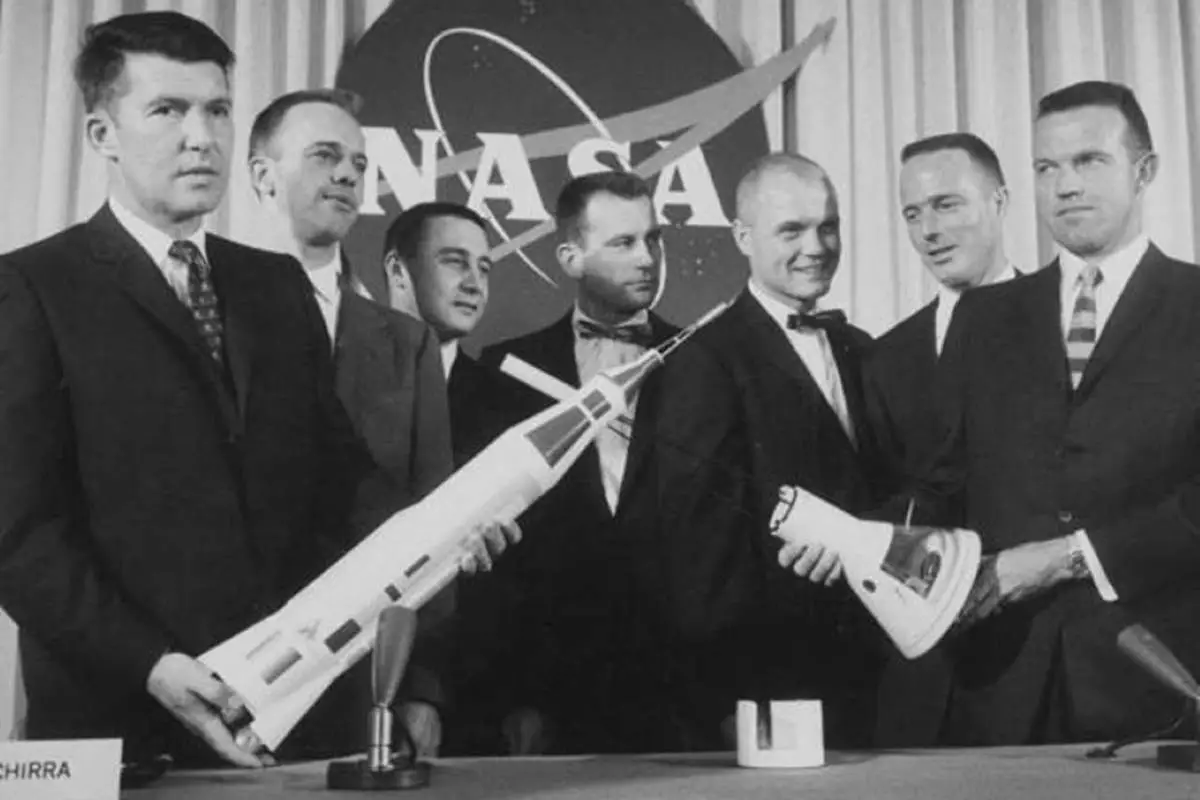On April 9, 1959, NASA introduced the Original Seven Mercury astronauts to the public, who are commonly known as the “Mercury Seven”. With Project Mercury, the United States gained its first experience in conducting human space missions that provided scientific and engineering knowledge for astronauts in space.
Today’s (April 9) story of what happened this day in Science, Technology, Astronomy, and Space Exploration history.
The Mercury Seven
United States’ first seven astronauts were (they are also referred to as the Original Seven and Astronaut Group 1):
- Alan B. Shepard Jr. (November 18, 1923 – July 21, 1998)
- Donald K. “Deke” Slayton (March 1, 1924 – June 13, 1993)
- Virgil I. “Gus” Grissom (April 3, 1926 – January 27, 1967)
- L. Gordon Cooper Jr. (March 6, 1927 – October 4, 2004)
- Walter “Wally” Schirra Jr. (March 12, 1923 – May 3, 2007)
- John H. Glenn Jr. (July 18, 1921 – December 8, 2016)
- M. Scott Carpenter (May 1, 1925 – October 10, 2013)
These astronauts were chosen from 110 applicants.
All of the Mercury Seven eventually flew into space. Six of them flew on Project Mercury missions, the first human spaceflight program of the United States that run from 1958 through 1963. Slayton, who was grounded by a heart murmur, flew to space later with the Apollo-Soyuz Test Project Mission.
Only Alan B. Shepard Jr. walked on the moon. He became the second person and the first American to travel into space in 1961, and in 1971, he walked on the Moon. He was the commander of Apollo 14.
Grissom died alongside Edward H. White II (b. November 14, 1930) and Roger B. Chaffee (b. February 15, 1935) on January 27, 1967, when a flash fire swept through the Apollo 1 command module during a launch rehearsal test. The three men inside perished despite the best efforts of the ground crew.
Video: April 9, 1959 press conference introducing the Mercury Seven astronauts to the public
Mercury Seven selection criteria
Unites States’ first astronauts’ selection criteria. Astronauts had to be:
- Less than 40 years old
- Less than 5 feet 11 inches (1.80 m) tall (the Mercury spacecraft, which could not accommodate someone taller)
- In excellent physical condition
- With a bachelor’s degree or equivalent
- A graduate of test pilot school
- With a minimum of 1,500 hours of total flying time
- Being a qualified jet pilot
The selection procedures for Project Mercury were directed by a NASA selection committee.
Each of the 110 candidates endured even more stringent physical, psychological, and mental examinations, including total body x-rays, pressure suit tests, cognitive exercises, and a series of unnerving interviews. Of the 32 candidates, 18 were recommended for Project Mercury without medical reservations.
On April 1, 1959, Robert Gilruth, the head of the Space Task Group, and Donlan, North, and White selected the first American astronauts. The “Mercury Seven” were Scott Carpenter, L. Gordon Cooper, Jr., John H. Glenn, Jr., Virgil I. “Gus” Grissom, Walter M. Schirra, Jr., Alan B. Shepard, Jr., and Donald K. “Deke” Slayton.
The “Mercury Seven” astronauts were announced to the public on April 9, 1959, at a press conference in Washington, D.C.


Sources
- “The Mercury Seven Astronauts: NASA’s First Space Travelers” on Space.com
- Mercury Seven on Wikipedia
- “60 Years Ago: NASA Introduces Mercury 7 Astronauts” on NASA.gov
- “The 40th Anniversary of the Mercury Seven” on the NASA History website
- Moon Landings: All-Time List [1966-2025] - February 2, 2025
- What Is Max-Q and Why Is It Important During Rocket Launches? - January 16, 2025
- Top 10 Tallest Rockets Ever Launched [2025 Update] - January 16, 2025
